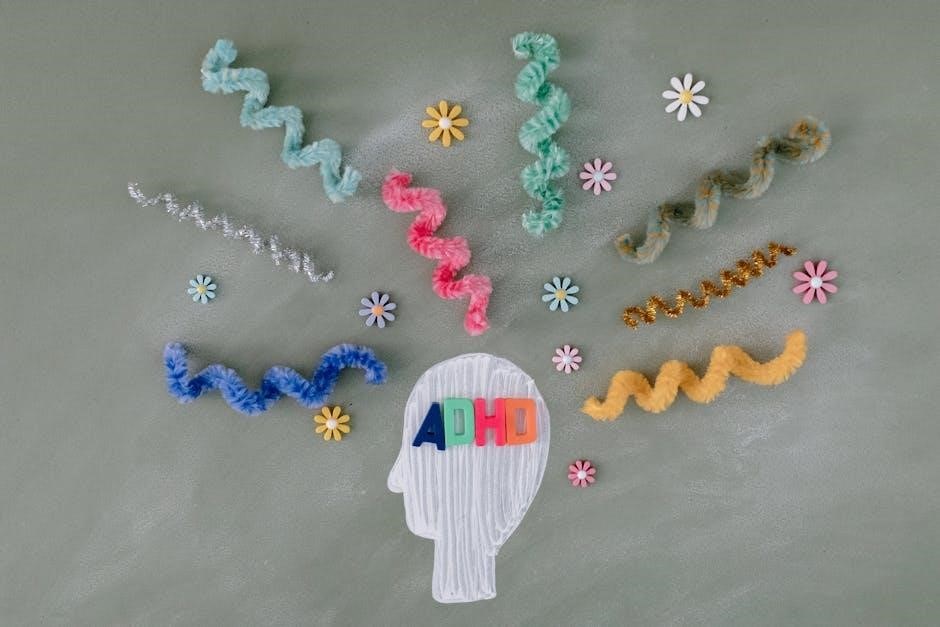
trauma and the brain pdf
Trauma profoundly impacts the brain‚ altering emotional regulation‚ memory‚ and behavior. It affects key brain regions‚ triggering long-term psychological and neurological changes. Understanding this complex interplay is essential for effective recovery strategies and interventions.
1.1. Definition of Trauma and Its Impact on the Brain
Trauma refers to psychological or emotional distress caused by disturbing events‚ such as abuse‚ accidents‚ or combat. It profoundly affects brain function‚ altering emotional regulation‚ memory processing‚ and decision-making. The hippocampus‚ amygdala‚ and prefrontal cortex are particularly impacted‚ leading to heightened fear responses‚ impaired memory‚ and reduced executive functioning. Chronic trauma can cause structural brain changes‚ increasing cortisol levels and predisposing individuals to mental health disorders like PTSD.
1.2. Overview of Brain Regions Affected by Trauma
Trauma impacts key brain regions‚ including the hippocampus‚ amygdala‚ prefrontal cortex‚ and thalamus. The hippocampus‚ crucial for memory processing‚ is often impaired‚ leading to fragmented memories. The amygdala‚ which processes fear‚ becomes hyperactive‚ causing heightened anxiety. The prefrontal cortex‚ responsible for executive functioning‚ may shut down during trauma‚ affecting decision-making. The thalamus‚ regulating sensory information‚ can malfunction‚ altering perception and emotional responses. These changes disrupt normal brain function and behavior.
Brain Regions Affected by Trauma
Trauma impacts the hippocampus‚ amygdala‚ prefrontal cortex‚ and thalamus‚ disrupting memory‚ fear responses‚ executive functioning‚ and sensory processing‚ leading to significant changes in brain function and behavior.
2.1. The Role of the Hippocampus in Processing Traumatic Memories
The hippocampus plays a critical role in processing and consolidating traumatic memories‚ especially during sleep. It helps transform short-term memories into long-term ones‚ reducing their emotional intensity. However‚ trauma can impair hippocampal function‚ leading to fragmented or unresolved memories. This disruption can result in vivid‚ distressing recollections that feel “stuck” in time‚ contributing to conditions like PTSD. Understanding this process is key to developing effective therapeutic interventions.
2.2. The Amygdala and Its Response to Threat
The amygdala‚ often called the “alarm bell” of the brain‚ is central to processing fear and threat. It triggers the body’s fight-or-flight response‚ releasing stress hormones like cortisol. Trauma can hyperactivate the amygdala‚ making it oversensitive to perceived threats. This leads to heightened anxiety and hypervigilance‚ as the brain remains in a state of alertness‚ even in safe environments. Overactivation disrupts emotional regulation and can impair rational thinking by overwhelming the prefrontal cortex.
2.3. The Prefrontal Cortex and Executive Functioning
The prefrontal cortex manages executive functions like decision-making‚ planning‚ and emotional regulation. Trauma can impair this region‚ reducing its ability to regulate emotions and thoughts. This leads to difficulties in focusing‚ impulse control‚ and rational thinking. Over time‚ repeated trauma may shrink the prefrontal cortex‚ worsening executive dysfunction and contributing to long-term behavioral and cognitive challenges. This impairment affects daily functioning and overall well-being‚ requiring targeted interventions for recovery.
2.4. The Thalamus as a Gatekeeper of Information
The thalamus acts as the brain’s gatekeeper‚ regulating sensory and emotional information flow. Trauma can disrupt its filtering ability‚ leading to sensory overload and heightened stress responses. This disruption affects how traumatic memories are processed‚ often causing vivid flashbacks and emotional reactivity. The thalamus’s altered function may also impair memory consolidation‚ contributing to fragmented recollections and difficulties in recovering from traumatic experiences. Its role in information processing is crucial for overall brain health and recovery.

Types of Traumatic Brain Injuries (TBI)
Traumatic brain injuries (TBI) are classified into mild and severe categories. Mild TBI‚ like concussions‚ causes temporary symptoms‚ while severe TBI leads to prolonged cognitive and motor impairments. TBI often results from falls‚ car accidents‚ or sports injuries‚ impacting brain function and recovery processes significantly.
3.1. Mild Traumatic Brain Injury (mTBI)
Mild traumatic brain injury (mTBI)‚ often called a concussion‚ results from a forceful bump‚ blow‚ or jolt to the head or body. Symptoms include headaches‚ dizziness‚ confusion‚ and cognitive difficulties. Most mTBI cases recover fully within weeks‚ but some individuals experience prolonged symptoms. mTBI is commonly caused by falls‚ car accidents‚ or sports injuries. Early diagnosis and rest are crucial for optimal recovery‚ though some cases may require medical monitoring due to persistent effects.
3.2. Severe Traumatic Brain Injury
Severe traumatic brain injury (TBI) results from significant head trauma‚ causing prolonged loss of consciousness‚ cognitive impairments‚ and memory deficits. It often stems from high-speed accidents‚ falls‚ or penetrating head injuries. Damage can lead to structural brain changes‚ impacting emotional regulation‚ executive functioning‚ and personality. Recovery is typically prolonged‚ requiring extensive rehabilitation. Early intervention is critical to improve outcomes and reduce long-term neurological and psychological consequences.

Psychological Trauma and the Brain
Psychological trauma alters brain circuitry‚ affecting emotional regulation and memory. Chronic stress changes the stress response system‚ increasing cortisol levels and impacting brain regions like the amygdala and hippocampus.
4.1. Post-Traumatic Stress Disorder (PTSD)
Post-Traumatic Stress Disorder (PTSD) develops after exposure to traumatic events‚ causing intrusive memories‚ heightened arousal‚ and avoidance behaviors. It alters brain circuitry‚ particularly in the amygdala and hippocampus. Increased cortisol levels and amygdala overactivity lead to hyperresponsive threat detection. PTSD disrupts emotional regulation and memory processing‚ resulting in long-term psychological and neurological changes that impair daily functioning and overall well-being.
4.2. The Stress Response System and Cortisol
Trauma activates the stress response system‚ releasing cortisol‚ a hormone that prepares the body for “fight or flight.” Chronic cortisol elevation disrupts brain regions like the hippocampus and amygdala‚ impairing emotional regulation and memory. This hormonal imbalance can lead to hyperarousal‚ anxiety‚ and memory impairments‚ significantly impacting mental health and overall brain function in individuals exposed to traumatic events.
Effects of Trauma on Brain Function
Trauma alters brain function‚ affecting emotional regulation‚ memory‚ and cognitive processes. It disrupts neural circuits‚ leading to challenges in managing stress and maintaining mental well-being.
5.1. Impaired Emotional Regulation
Trauma disrupts emotional regulation by altering prefrontal cortex function‚ which manages emotions and rational thinking; This impairment leads to heightened amygdala activity‚ causing increased anxiety and fear responses. Individuals may experience intense mood swings‚ difficulty calming down‚ and challenges in managing emotional distress. This disruption can result in prolonged psychological distress and interfere with daily functioning‚ highlighting the need for targeted interventions to restore emotional balance.
5.2. Changes in Brain Circuitry
Trauma alters brain circuitry by strengthening fear pathways and weakening regulatory pathways‚ leading to heightened stress responses. The amygdala becomes hyperactive‚ while the prefrontal cortex loses connectivity‚ impairing emotional control. These changes disrupt communication between brain regions‚ affecting decision-making and emotional stability. Over time‚ this rewiring can result in chronic anxiety‚ impulsivity‚ and mood disorders‚ emphasizing the need for interventions to restore balanced neural communication and function.
5.3. Memory Impairments
Trauma disrupts memory processing‚ leading to impairments in encoding‚ storage‚ and retrieval. Declarative memory‚ which stores factual information‚ is often affected‚ while emotional memories linked to trauma can become hyper-vivid. Fragmented or lost memories may result‚ complicating daily functioning. The hippocampus‚ crucial for memory consolidation‚ is particularly vulnerable‚ with reduced volume and functionality observed in trauma survivors‚ exacerbating memory-related challenges and contributing to conditions like PTSD.

Diagnostic Approaches
Diagnosing trauma-related brain changes involves neuroimaging (MRI‚ CT scans) and clinical assessments; These tools help identify structural and functional impairments‚ guiding tailored treatment plans effectively.
6.1. Neuroimaging Techniques (MRI‚ CT Scans)
Neuroimaging techniques like MRI and CT scans are crucial for diagnosing trauma-related brain injuries. MRI provides detailed images of brain structures‚ identifying abnormalities such as swelling or bleeding. CT scans are faster and often used in emergencies to detect acute injuries. These tools help assess structural damage and guide treatment plans‚ ensuring accurate diagnoses and effective interventions for traumatic brain injuries.
6.2. Clinical Assessments and Symptom Monitoring
Clinical assessments and symptom monitoring are vital for evaluating the impact of trauma on the brain. Healthcare professionals use standardized tools to assess cognitive‚ emotional‚ and physical symptoms. Regular monitoring helps identify progression or regression of symptoms‚ enabling timely adjustments to treatment plans. This approach ensures comprehensive care‚ addressing both immediate and long-term effects of traumatic brain injuries and supporting optimal recovery outcomes.

Treatment and Recovery Strategies
Treatment involves evidence-based therapies like EMDR and cognitive rehabilitation‚ aiding recovery by enhancing neuroplasticity and addressing emotional‚ cognitive‚ and neurological challenges caused by trauma.
7.1. EMDR Therapy for Traumatic Memories
EMDR (Eye Movement Desensitization and Reprocessing) therapy helps process traumatic memories by reducing their distressing effects. It mimics brain processes during sleep‚ promoting memory integration. This therapy enhances emotional regulation‚ decreases hyperarousal‚ and improves cognitive functioning. By reprocessing traumatic events‚ EMDR facilitates healing and reduces long-term psychological impacts‚ fostering resilience and recovery in individuals affected by trauma.
7.2. Cognitive Rehabilitation Programs
Cognitive rehabilitation programs address deficits in memory‚ attention‚ and executive functioning caused by traumatic brain injury. These structured interventions aim to improve daily functioning through targeted exercises and strategies. Techniques include memory aids‚ compensatory strategies‚ and cognitive training. Such programs enhance neural adaptability‚ fostering practical skills and promoting independence in individuals recovering from trauma-related cognitive impairments.
The Role of Neuroplasticity
Neuroplasticity enables the brain to reorganize itself after trauma‚ fostering recovery and adaptation. This dynamic process supports neural repair‚ enhancing functional outcomes and compensating for damaged pathways.
8.1. Brain Recovery and Stabilization
Brain recovery after trauma involves neural plasticity‚ where damaged areas are compensated by reorganizing neural pathways. This process occurs over weeks to months‚ with rest‚ therapy‚ and a supportive environment aiding stabilization. Early interventions enhance recovery outcomes‚ promoting adaptive changes in brain circuitry. While some individuals achieve full recovery‚ others may experience persistent deficits‚ emphasizing the need for tailored rehabilitation strategies.
8.2. Therapeutic Strategies to Enhance Neuroplasticity
Therapies like EMDR and cognitive rehabilitation target neuroplasticity‚ helping the brain reorganize and adapt. These strategies promote neural recovery by strengthening weakened pathways and fostering new connections. Mindfulness practices and medication management further support brain health‚ enhancing resilience and reducing stress. Such approaches aim to restore functional brain circuitry‚ improving emotional and cognitive outcomes for individuals recovering from trauma.

Societal Impact of Traumatic Brain Injuries
Traumatic brain injuries impose significant public health‚ economic‚ and societal burdens‚ impacting productivity‚ healthcare systems‚ and families‚ while necessitating comprehensive support structures and interventions.
9.1. Public Health and Socioeconomic Consequences
Traumatic brain injuries pose a significant public health crisis‚ affecting millions annually. They lead to disabilities‚ unemployment‚ and increased healthcare costs‚ placing a substantial economic burden on families and society. The socioeconomic consequences include lost productivity‚ medical expenses‚ and strained healthcare systems‚ emphasizing the need for comprehensive prevention and support strategies to mitigate these far-reaching impacts.
9.2. The Burden on Healthcare Systems
Traumatic brain injuries place a significant strain on healthcare systems‚ with approximately 69 million cases annually. These injuries‚ often resulting from accidents or violence‚ demand extensive medical resources‚ including emergency care‚ rehabilitation‚ and long-term support. The financial burden is substantial‚ with high costs for treatment‚ rehabilitation‚ and ongoing care‚ further straining healthcare infrastructure and resources globally.
Understanding trauma’s impact on the brain is crucial for advancing treatments and improving outcomes. Early intervention‚ coupled with research into neuroplasticity‚ offers hope for recovery and rehabilitation of trauma survivors.
10.1. Advances in Research and Treatment
Recent breakthroughs in neuroscience and psychology have expanded our understanding of trauma’s impact on the brain. Innovations like EMDR therapy and cognitive rehabilitation programs show promise in addressing traumatic memories and improving brain function. Advances in neuroplasticity research highlight the brain’s potential for recovery. Early intervention strategies are being refined to mitigate long-term effects‚ offering hope for more effective trauma care and rehabilitation in the future.
10.2. The Importance of Early Intervention
Early intervention is crucial in mitigating the long-term effects of trauma on the brain. Prompt treatment‚ such as EMDR or cognitive rehabilitation‚ can prevent chronic conditions like PTSD and enhance recovery. Addressing trauma early fosters neuroplasticity‚ helping the brain reorganize and adapt. This approach reduces symptoms‚ improves emotional regulation‚ and restores functional brain circuitry‚ offering individuals a better quality of life and faster recovery outcomes.
Related Posts

acls exam version c answers pdf
Get ACLS Exam Version C answers in PDF format. Free study guide, practice questions, and instant download. Prepare smarter, not harder!

explaining adhd to a child pdf
Learn how to explain ADHD to children in a simple, engaging way. Download our free PDF guide to help kids understand and manage their ADHD.

john paul jackson books pdf free download
Access John Paul Jackson’s books for free in PDF. Instantly download his spiritual teachings and revelations.